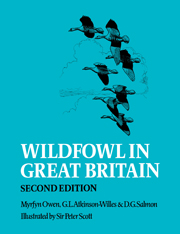Book contents
- Frontmatter
- Contents
- List of location maps
- Foreword by William Wilkinson
- Acknowledgements
- Conventions and abbreviations
- Part I Introduction
- Part II The survey of wildfowl habitat and distribution
- Part III Species accounts
- Part IV The conservation of wildfowl and their habitats
- Conclusion
- References
- Indexes
Conclusion
Published online by Cambridge University Press: 04 August 2010
- Frontmatter
- Contents
- List of location maps
- Foreword by William Wilkinson
- Acknowledgements
- Conventions and abbreviations
- Part I Introduction
- Part II The survey of wildfowl habitat and distribution
- Part III Species accounts
- Part IV The conservation of wildfowl and their habitats
- Conclusion
- References
- Indexes
Summary
Having reviewed the considerable progress made in the conservation of wildfowl and their habitats in the 1950s, the First Edition ended on an optimistic note, concluding that science was playing an increasingly important part in the process of conservation. Reviewing the position since then, we are again justifiably pleased with the progress. Two major developments give us particular grounds for optimism. One is the emergence of the International Waterfowl Research Bureau as a major force in international conservation, leading to the establishment of the Ramsar Convention. The commitment of the Nature Conservancy Council and the government to the Convention is illustrated by the fact that the list of sites proposed for designation under Ramsar includes all those wetlands qualifying under the 1% criterion. The other major development in the 1970s was in the contribution made by the voluntary organisations to the conservation of our wetland habitats.
The Wildlife and Countryside Act (1981) increased the number of wildfowl given protection in law and also extended protection to habitats in the case of SSSIs. The NCC has the burden of making this legislation work in practice. There have been setbacks, but we hope that landowners and conservationists can work together to protect our most important sites. An encouraging and extremely important factor is the growth in public interest and involvement in aspects of conservation in recent years.
Our challenge now is to maintain and build on this favourable situation and safeguard our wetlands for the future. Since wildfowlers, voluntary and governmental conservation bodies and many other organisations are working together, we are hopeful that we will succeed.
- Type
- Chapter
- Information
- Wildfowl in Great Britain , pp. 550Publisher: Cambridge University PressPrint publication year: 1986

